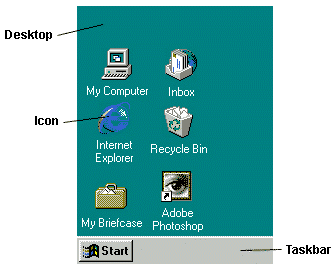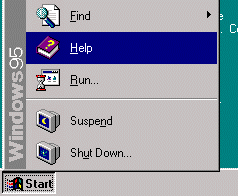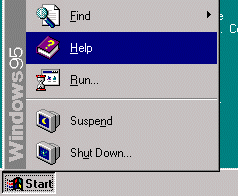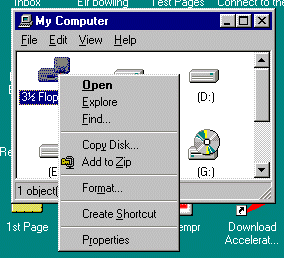|
OCEAN COUNTY ACADEMY OF THE ARTS • GRAPHIC DESIGN TECHNOLOGY PROGRAM |
|
One of the most important skills for beginning computer artists to understand, is the importance of basic Windows operations and "file management". This pertains to the opening, saving, importing, exporting, deleting, and printing of files. The student must be able to perform these tasks in order to find and maintain employment in the visual communications field. Before the student works with files, there is some important theory to learn about basic Windows, files and filenames.
What Is An Operating System?
The Operating System is the software program that controls the
event management (processing) and hardware associated with a computer.
The operating system is the first piece of software loaded into memory when a computer
starts. It is the operating system that launches/starts other software programs such as
word processors, spreadsheets, databases, paint programs, web browsers, etc. The operating
system manages all of the resources on the computer; it controls the mouse, the monitor,
the printer, the drives, the scanner, etc.
On IBM compatible computers, possible operating systems include DOS, Windows 3.1, Windows
95, Windows 98, Windows NT 4.0, OS2, and Linux.
DOS is an old (early 80's) command line operating system which requires
the user to memorize and enter all commands from a command prompt.
Windows 3.1 (late 80's) was Microsoft's first attempt at a Macintosh-like
Graphical User Interface (GUI); this interface allowed (1) programs to be launched by
double-clicking icons with a mouse, (2) files to be copied by drag and drop, and (3) much
easier copy & paste. The Windows 3.1 operating system was a 16 bit operating system.
Windows 95, Windows 98, and Windows NT are the current state-of-the-art
32 bit operating systems. They have greatly enhanced the GUI and have proven to be both
significantly more powerful and significantly more reliable than the Windows 3.1 operating
system.
OS2 is began as a joint venture between IBM and Microsoft. IBM finished
and marketed this operating system. It is not used extensively today. There are a few
business applications still running on this operating system.
Linux is a freely distributed UNIX operating system for the Intel
architecture. Linux has all of the utilities to provide printer service, ftp service,
network file service, web page service, mail service, and internet service to a host of
computers. The current version of Linux is Red Hat Linux.
Most of the program workstations use Windows 98 or Windows NT.
The interface and functionality of these operating systems are so similar that users often
don't notice the difference between the them.
Most Macintosh computers use an operating system called MacOS. There is also a freely
distributed version of Linux available for the Macintosh computer.
When the computer is turned on, it checks the system through a hardware/software BIOS first and then the next thing that is done, is the loading of the Windows Operating System software. This software is the main software for any of the programs that run under it. All programs utilize the basic functions of the Windows software. It is the understanding of the basic Windows "file management" operations that will enable the student to adapt to other software programs. Therefore, it is important for the student to learn file management procedures such as running, saving, and printing files.
The illustration below shows a portion of the Windows "desktop". The "Desktop" is the display on the main Windows screen before any other applications are loaded. It consists of the "desktop", the program "icons" and the Windows "taskbar".

The beginning student needs to fully understand the parts of a window in order to function as an electronic graphic artist. There will be many times when the student must resize, minimize, open and close windows as a normal operation when working in one or multiple programs. The basic window does not really change too much from program to program. There will almost always be "File", "Edit", "View", and "Help" selections on the program's menu bar. Once the student is familiar with these basic functions, it becomes easier to adapt to other programs. Use the illustration below to help you learn the basic parts.

What are "folders" and why are they necessary?
Folders are simply an area on a disk where files are stored. Think
of a computer as a large file cabinet. A computer has a hard disk drive. A file cabinet
has drawers. In a file cabinet drawer, there are folders containing pieces of paper. Think
of the drawer as a hard drive, the folders as folders on a computer and the pieces of
paper in the folders as computer files. This is the most basic way to explain how the
storage of files on a computer works.
As we work on the computer, it becomes necessary to stop and save our work to come back to
it later. That is why we need to create folders. We store our work in the folder as files,
and we can cgo back and work with those files again at another time.
Computer programs are also stored on the computer in folders. Each program sets up its own
unique folder and also sub folders to store all of the important information it needs to
perform correctly. If any of these files become lost or damaged (corrupted) the program
may no longer be able to function. Therefore it is important to never change or alter
files unless you are absolutely certain that you are not going to damage existing files.
![]()
The taskbar is located at the bottom of the screen. This bar can be hidden (auto hide); if
so, move the mouse to the bottom of the screen and it will appear. The Start button is on
the left; it provides a short-cut opportunity to launch applications.
Windows 95, Windows 98, & Windows NT are true muli-tasking operating systems;
this means that two or more programs can run at the same time. Examination of the task bar
below shows that Paint Shop Pro (graphic program) and Netscape (WWW browser) are running.
Pressing the Netscape button will bring this program to the forefront. Pressing the Paint
Shop Pro button will bring it to the forefront.
The time will often be displayed in the bottom right corner of the taskbar; the form may be altered in the control panel.
One of the last items to be standardized on computers is the storage of information on disks. The process of preparing a disk to receive information is called formatting. All disks must be formatted! A Windows (IBM) disk is formatted differently than a Macintosh (Apple) disk. A UNIX machine uses still a different format.

Hard disks and floppy disks have a top surface and a bottom surface.
Information is generally stored on both surfaces. Concentric circles divide each side of
the disk surface into tracks (figure a). The size and number of tracks is machine
dependent; this is determined by the blend of installed hardware and software. High
density floppy disks have more tracks than low density floppy disks.
Pizza style partitions further partition the disk surface into sectors (figure b). The
size and number of sectors is also machine dependent.

The portion of a single track in a single sector is
called a block (figure c). The size of the block is also machine dependent.
Information is generally transferred to the disk by read/write heads that physically move
across the surface of the disk until the head is above the desired track (d). The time
required to move the head to the right track is called the seek time. Once the read/write
head moved to the right track, information may not be written to or read from the disk
until the spinning disk rotates the desired block beneath the read/write head; this time
is referred to as the rotational delay.
The disk operating system automatically keeps track of those blocks that contain good
information and those blocks which are available for new files. A small file may be stored
within a single block. A large files will span many blocks; suppose that blocks 22, 104,
18, and 37 were used to store an Inventory file. It is the disk operating systems
responsibility to maintain a table that enables the user access specific files. File
information is continually added, deleted, or altered; these transactions cause the files
to increase and decrease in size. These transactions cause the files become fragmented
(scattered across many tracks and/or sectors and/or surfaces); this is why the Inventory
file above might be scattered on blocks 22, 104, 18, and 37.
If the Inventory file could be placed in contiguous blocks on the same track, the time
required to read the file, copy the file, or update the file would be reduced. Most
computers have commercial programs, called disk optimizer, that can be purchased and run
to group file blocks for optimal access; a disk optimizer is a program which corrects disk
fragmentation. Disk optimizers are currently being included in some operating systems.
There are two basic ways to begin using programs on your workstation. The first way is to use the "Start" button and the "Programs" menu.

To see a list of programs and/or to start a program, click
on "Start" and then "Programs.
The second way to run a program or launch an application is to "double-click" a program icon on the Windows Desktop.
Computers running Windows 95/98/NT should be shut down properly; this shut down process often updates files on the hard drive. Simply turning off the computer can cause disk errors and usage of valuable hard disk space with temporary files. You should always log off your workstation. Failure to do so may enable others to access your email, your projects, or private data. You should always wait until the operating system displays a message telling you it is ok to turn off the computer.

Shut down the computer by clicking on the "Start" icon
and then clicking "Shut Down". Wait for the computer
to display the "Shut Down" message. It varies, depending
on which version of Windows is being used.
The Windows Operating System software contains a helpful utility that can be found through the use of the "Start" button on the bottom left hand side of the "taskbar". Most Windows applications (programs) also have built-in help programs. These are usually found as the final word or entry on the menu bar at the top of the program.

The "Help" icon can be found in the "Start"
menu.
Using the Windows operating system, it is possible to
duplicate not only just files, but entire disks. The illustration and caption below
explain the procedure for copying a disk.

Double-click on "My Computer" to
display disk drives.
Right-click on Floppy Disk (A:)
Click on Copy Disk ...

Select Start.
Select OK [Have Inserted Original Source].
Select OK [Have Inserted Destination Disk].
Select Close.
How does a computer know what each file is for?
Each file and folder on a computer or disk has a "file name". The filename is given to the file by whoever creates it. However, there is a part of a filename that is very important. It is called a file name extension. The file name extension consists of a period (called a "dot") followed by three (or sometimes more) letters. For instance, "report.txt" could be a file name. The ".txt" would tell the computer that this file is a text file (.txt). Then the computer knows which program to use to open it. The file would be able to be opened in a word processor program, and possibly some others. However, the file may not be able to be opened in other programs. That is why a filename extension is so important.
Do I have to learn all the file extensions?
File extensions are usually created automatically when saving a file
in a particular program. However, it will be necessary to become familiar with many types
of file formats if you wish to work in graphic design, digital photography, multimedia,
web design, or digital video. As you learn the specific software programs in each area,
you will also learn more about the files created from those programs and the file name
extensions associated with those programs. This topic will be expanded upon in the next
web page entitled "The Basics of Computer Graphics".
When you have completed reviewing this material and have completed the review questions, you may wish to read it over again. There will be a test on this material. |
Go Back to the Art for
Reproduction Menu Page